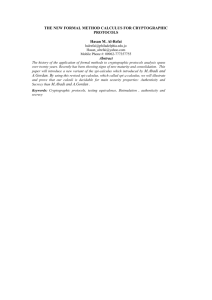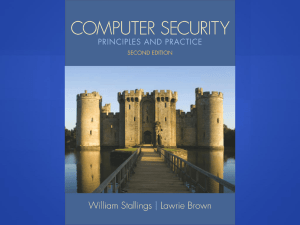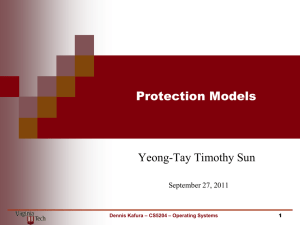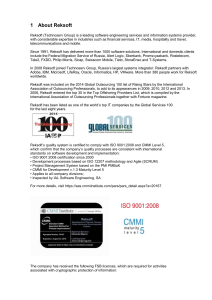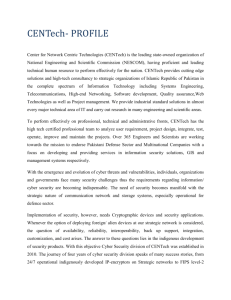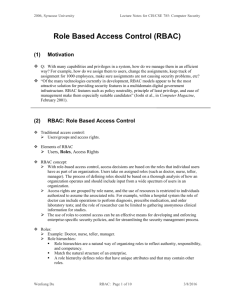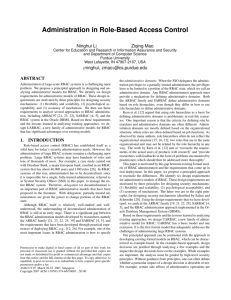Trust Enhanced Crypt..
advertisement
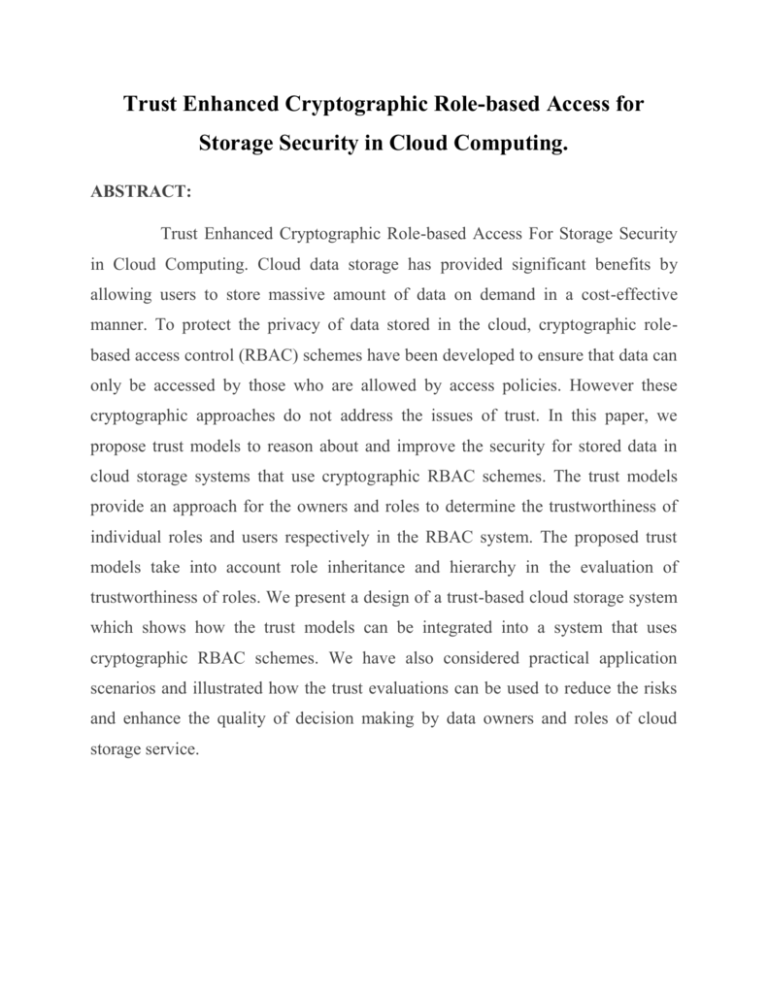
Trust Enhanced Cryptographic Role-based Access for Storage Security in Cloud Computing. ABSTRACT: Trust Enhanced Cryptographic Role-based Access For Storage Security in Cloud Computing. Cloud data storage has provided significant benefits by allowing users to store massive amount of data on demand in a cost-effective manner. To protect the privacy of data stored in the cloud, cryptographic rolebased access control (RBAC) schemes have been developed to ensure that data can only be accessed by those who are allowed by access policies. However these cryptographic approaches do not address the issues of trust. In this paper, we propose trust models to reason about and improve the security for stored data in cloud storage systems that use cryptographic RBAC schemes. The trust models provide an approach for the owners and roles to determine the trustworthiness of individual roles and users respectively in the RBAC system. The proposed trust models take into account role inheritance and hierarchy in the evaluation of trustworthiness of roles. We present a design of a trust-based cloud storage system which shows how the trust models can be integrated into a system that uses cryptographic RBAC schemes. We have also considered practical application scenarios and illustrated how the trust evaluations can be used to reduce the risks and enhance the quality of decision making by data owners and roles of cloud storage service. ARCHITECTURE: EXISTING SYSTEM: As an extension of the owners’ RBAC trust model, our trust models have also addressed the roles’ trust on users. The existing works control the access privileges of a user depending on his or her trust level. The differences between our model and the existing ones are that our roles’ trust model works in the RBAC systems which use cryptographic RBAC schemes. That is, our models take into account cryptographic operations and the access privilege to decrypt the data stored in the cloud, which none of the existing works address. PROPOSED SYSTEM: The proposed trust models take into account role inheritance and hierarchy in the evaluation of trustworthiness of roles. We present a design of a trust-based cloud storage system which shows how the trust models can be integrated into a system that uses cryptographic RBAC schemes. Many access control models have been proposed over the years in the literature. In this context, role-based access control (RBAC) is a well-known access control model which can help to simplify security management especially in large-scale systems. In the RBE scheme proposed in the paper the users management can be decentralized to individual roles; that is, the administrators only manage the roles and the relationship among them while the roles have the flexibility in specifying the user memberships themselves. The proposed trust models address the missing aspect of trust in cryptographic RBAC schemes to secure data storage in the cloud, and can provide better protection of stored data than using cryptographic approaches alone. The paper has proposed trust models for owners and roles in RBAC systems which are using cryptographic RBAC schemes to secure stored data. ALGORITHMS All the required algorithms in the RBE scheme have been executed properly to setup the system parameters. We first look at the case where an owner wants to encrypt a message M to the role R3. The inputs of the RBE encryption are the system public keys pk and the role public parameters pubR3 of R3, and the output of the algorithm is the cipher text tulle. RBE decryption algorithm to recover the message M, and the inputs of the algorithm are pk, the role public parameters pub R1 the user decryption key dkU1 and the cipher text C. The algorithm outputs the message M if the decryption key dkU1 that U1 holds is valid. Trust issues that need to be considered by the data owners and role managers of a cryptographic RBAC system. MODULE DESCRIPTION Experience-based Trust Role-based Encryption Trust issues in using cryptographic RBAC schemes in secure cloud storage Data Owners’ Trust in Role Managers Owner-role RBAC trust model Trust Model Role Managers’ Trust in Data Users Role-user RBAC trust model Conclusion EXPERIENCE-BASED TRUST Trust has played a foundational role in security for a long period of time. Most experience-based trust systems derive the trustworthiness of an entity from both its own experience and the feedback on the transactions provided by other entities which have had interactions with the entity concerned in the past. Let us consider a simple example of such a system. When a client c finishes a transaction with a service provider p, c gives a feedback as either “positive” or “negative” depending on whether or not c is satisfied with the transaction. The feedback record is of the form f = (c; p; b; t) where b represents the binary value of the feedback and t is the timestamp when the transaction took place. This record f is uploaded by the client to a trust central repository. Role-based Encryption A cryptographic RBAC scheme integrates encryption scheme with RBAC model to enforce the access control policies in an entrusted environment. This approach allows data to be encrypted in the way that the cipher text can only be decrypted by those which are allowed by the access policies. A hierarchical cryptographic access control scheme was proposed in 1983. Because of the similarity in structures between hierarchical access control and RBAC, a hierarchical cryptographic access control scheme can be easily transformed into a cryptographic RBAC scheme. The problem of access control for securely outsourcing data using cryptographic techniques was first considered in [12]. Several cryptographic access control approaches have been investigated in [2], [13], [14] to address the problem of secure data access and cost effective key management in distributed environments. Among the cryptographic RBAC schemes in the literature, role-based encryption (RBE) schemes [6], [8] have achieved many superior characteristics compared to other solutions in terms of efficiency and flexibility. In this section, we review several concepts in RBE schemes and briefly describe how it works to assist understanding our proposed trust models. We first describe four types of entities which are involved in a RBE scheme, The system administrator of the system. It generates the system parameters and issues all the necessary credentials. In addition, this administrator manages the role hierarchy structure for the RBAC system RM is a role manager who manages the user membership of a role. In systems where there are a small number of users, the SA can act as the role manager to manage the user membership of each role to keep the systems compact. However, in large-scale systems, it is almost. TRUST ISSUES IN USING CRYPTOGRAPHIC RBAC SCHEMES IN SECURE CLOUD STORAGE Trust issues in using cryptographic rbac schemes in secure cloud storage. By using cryptographic RBAC schemes in cloud storage systems, a data owner can encrypt the data to a role, and only the users who have been granted the membership to the role or the ancestor role of that role can decrypt the data. In this paper, we assume that the data owners and users reside outside this role system infrastructure (where the roles are being administered). Hence the issues to consider are how the data owners can decide whether or not to trust the role managers in the system and how the role managers can decide whether and how much to trust the users in the system. Owners consider the trust of role managers in order to ensure that their data is secure after being assigned to the roles, and role managers consider the trust of users so that users with negative behaviors are excluded from the roles, which in turn makes owners trust these roles. In this section, we discuss the trust issues that need to be considered by the data owners and role managers of a cryptographic RBAC system. New Technology Ajax toolkit Stored procedures JavaScript J query CSS SYSTEM SPECIFICATION Hardware Requirements: System : Pentium IV 2.4 GHz. Hard Disk : 40 GB. Floppy Drive : 1.44 Mb. Monitor : 14’ Colour Monitor. Mouse : Optical Mouse. Ram : 512 Mb. Software Requirements: Operating system : Windows 7 Ultimate. Coding Language : ASP.Net with C# Front-End : Visual Studio 2010 Professional. Data Base : SQL Server 2008.
